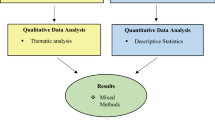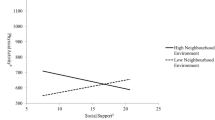Abstract
Objective:
To analyse whether an individual’s neighbourhood influences the uptake of weight management strategies and whether there is an interaction between individual socio-economic status and neighbourhood deprivation.
Methodology:
Data were collected from the Yorkshire Health Study (2010–2012) for 27 806 individuals on the use of the following weight management strategies: ‘slimming clubs’, ‘healthy eating’, ‘increasing exercise’ and ‘controlling portion size’. A multi-level logistic regression was fit to analyse the use of these strategies, controlling for age, sex, body mass index, education, neighbourhood deprivation and neighbourhood population turnover (a proxy for neighbourhood social capital). A cross-level interaction term was included for education and neighbourhood deprivation. Lower Super Output Area was used as the geographical scale for the areal unit of analysis.
Results:
Significant neighbourhood effects were observed for use of ‘slimming clubs’, ‘healthy eating’ and ‘increasing exercise’ as weight management strategies, independent of individual- and area-level covariates. A significant interaction between education and neighbourhood deprivation was observed across all strategies, suggesting that as an area becomes more deprived, individuals of the lowest education are more likely not to use any strategy compared with those of the highest education.
Conclusions:
Neighbourhoods modify/amplify individual disadvantage and social inequalities, with individuals of low education disproportionally affected by deprivation. It is important to include neighbourhood-based explanations in the development of community-based policy interventions to help tackle obesity.
This is a preview of subscription content, access via your institution
Access options
Subscribe to this journal
Receive 12 print issues and online access
$259.00 per year
only $21.58 per issue
Buy this article
- Purchase on Springer Link
- Instant access to full article PDF
Prices may be subject to local taxes which are calculated during checkout


Similar content being viewed by others
References
Ng M, Fleming T, Robinson M, Thomson B, Graetz N, Margono C et al. Global, regional, and national prevalence of overweight and obesity in children and adults during 1980–2013: a systematic analysis for the Global Burden of Disease Study 2013. Lancet 2014; e-pub ahead of print 1 July 2014; doi:10.1016/S0140-6736(14)60460-8.
Foresight. Tackling Obesities: Future Choices 2007. Available from http://www.bis.gov.uk/foresight/our-work/projects/published-projects/tackling-obesities/reports-and-publications. Last accessed 3 March 2014.
Dixon JB . The effect of obesity on health outcomes. Mol Cell Endocrinol 2010; 316: 104–108.
Flegal KM, Kit BK, Orpana H . Association of All-Cause Mortality With Overweight and Obesity Using Standard Body Mass Index Categories. JAMA 2013; 309: 71–82.
WHO. Obesity: Preventing and managing the global epidemic. World Health Organisation: Geneva, 2000.
Wang YC, McPherson K, Marsh T, Gortmaker SL, Brown M . Health and economic burden of the projected obesity trends in the USA and the UK. Lancet 2011; 378: 815–825.
Delva J, Johnston LD, O’Malley PM . The epidemiology of overweight and related lifestyle behaviors: racial/ethnic and socioeconomic status differences among American youth. Am J Prev Med 2007; 33: S178–S186.
Laaksonen M, Talala K, Martelin T, Rahkonen O, Roos E, Helakorpi S et al. Health behaviours as explanations for educational level differences in cardiovascular and all-cause mortality: a follow-up of 60 000 men and women over 23 years. Eur J Public Health 2008; 18: 38–43.
Van Nunen AMA, Wouters EJM, Vingerhoets AJJM, Hox JJ, Geenen R . The health-related quality of life of obese persons seeking or not seeking surgical or non-surgical treatment: a meta-analysis. Obes Surg 2007; 17: 1357–1366.
Han TS, Tajar A, Lean MEJ . Obesity and weight management in the elderly. Br Med Bull 2011; 97: 169–196.
Kakinami L, Gauvin L, Barnett TA, Paradis G . Trying to lose weight: the association of income and age to weight-loss strategies in the U.S. Am J Prev Med 2014; 46: 585–592.
McLaren L . Socioeconomic status and obesity. Epidemiol Rev 2007; 29: 29–48.
Clarke PJ, O’Malley PM, Johnston LD, Schulenberg JE, Lantz P . Differential trends in weight-related health behaviors among American young adults by gender, race/ethnicity, and socioeconomic status: 1984-2006. Am J Public Health 2009; 99: 1893–1901.
Siu J, Giskes K, Turrell G . Socio-economic differences in weight-control behaviours and barriers to weight control. Public Health Nutr 2011; 14: 1768–1778.
Boone-Heinonen J, Roux AVD, Kiefe CI, Lewis CE, Guilkey DK, Gordon-Larsen P . Neighborhood socioeconomic status predictors of physical activity through young to middle adulthood: The CARDIA Study. Soc Sci Med 2012; 72: 641–649.
Font JC, Fabbri D, Gil J . Decomposing cross-country differences in levels of obesity and overweight: does the social environment matter? Soc Sci Med 2010; 70: 1185–1193.
Macintyre S . Deprivation amplification revisited ; or, is it always true that poorer places have poorer access to resources for healthy diets and physical activity? Int J Behav Nutr Phys Act 2007; 7: 32.
Prince SA, Kristjansson EA, Russell K, Billette J-M, Sawada MC, Ali A et al. Relationships between neighborhoods, physical activity, and obesity: a multilevel analysis of a large Canadian city. Obesity 2012; 20: 2093–2100.
Stafford M, Brunner EJ, Head J, Ross NA . Deprivation and the development of obesity a multilevel, longitudinal study in England. Am J Prev Med 2010; 39: 130–139.
Caspi CE, Kawachi I, Subramanian SV, Tucker-Seeley R, Sorensen G . The social environment and walking behavior among low-income housing residents. Soc Sci Med 2013; 80: 76–84.
Kwarteng JL, Schulz AJ, Mentz GB, Zenk SN, Opperman AA Associations between observed neighborhood characteristics and physical activity: findings from a multiethnic urban community. J Public Health 2013; e-pub ahead of print 3 March 2014; doi:10.1093/pubmed/fdt099.
Legh-Jones H, Moore S . Network social capital, social participation, and physical inactivity in an urban adult population. Soc Sci Med 2012; 74: 1362–1367.
Pickett KE, Pearl M . Multilevel analyses of neighbourhood socioeconomic context and health outcomes: a critical review. J Epidemiol Community Health 2001; 55: 111–122.
Jack D, Neckerman K, Schwartz-Soicher O, Lovasi GS, Quinn J, Richards C et al. Socio-economic status, neighborhood food environments and consumption of fruits and vegetables in New York City. Public Health Nutr 2013; 16: 1197–1205.
Yoon J, Brown TT . Does the promotion of community social capital reduce obesity risk? J Socio Econ 2011; 40: 296–305.
Heslehurst N, Ells L, Simpson H, Batterham A, Wilkinson J, Summerbell C . Trends in maternal obesity incidence rates, demographic predictors, and health inequalities in 36 821 women over a 15-year period. BJOG 2007; 114: 187–194.
Diez-Roux AV, Nieto FJ, Muntaner C, Tyroler HA, Comstock GW, Shahar E et al. Neighborhood environments and coronary heart disease: a multilevel analysis. Am J Epidemiol 1997; 146: 48–63.
Finch BK, Do DP, Heron M, Bird C, Seeman T, Lurie N . Neighborhood Effects on Health: Concentrated Advantage and Disadvantage. Health Place 2010; 16: 1058–1060.
Jordan KP, Hayward R, Roberts E, Edwards JJ, Kadam UT . The relationship of individual and neighbourhood deprivation with morbidity in older adults: an observational study. Eur J Public Health 2013; 24: 396–398.
Shouls S, Congdon P, Curtis S . Modelling inequality in reported long term illness in the UK: combining individual and area characteristics. J Epidemiol Community Health 1996; 50: 366–376.
Stafford M, Marmot M . Neighbourhood deprivation and health: does it affect us all equally? Int J Epidemiol 2003; 32: 357–366.
Relton C, Bissell P, Smith C, Blackburn J, Cooper CL, Nicholl J et al. South Yorkshire Cohort: a “cohort trials facility” study of health and weight - protocol for the recruitment phase. BMC Public Health 2011; 11: 640.
Green MA, Li J, Relton C, Strong M, Kearns B, Wu M et al. Cohort Profile: The Yorkshire Health Study. Int J Epidemiol 2014; e-pub ahead of print 9 July 2014.
Link BG, Phelan J . Social conditions as fundamental causes of disease. J Health Soc Behav 1995; 35: 80–94.
ONS. Super Output Areas (SOAs): Frequently asked questions 2011. Available from http://neighbourhood.statistics.gov.uk/dissemination/Info.do?page=aboutneighbourhood/geography/superoutputareas/soafaq/soa-faq.htm. Last accessed 3 March 2014.
Martin D . Geography for the 2001 Census in England and Wales. Popul Trends 2002; 108: 7–15.
Hox JJ . Multilevel Analysis. LEA: London, 2002.
Department for Communities and Local Government. The English Indices of Deprivation 2010. DCLG: London, 2011.
Kawachi I, Berkman L . Social Cohesion, Social Capital, and Health. Berkman L, Kawachi i. Social Epidemiology. Oxford University Press: Oxford, 2000. 174–190.
Chaix B, Rosvall M, Merlo J . Neighborhood socioeconomic deprivation and residential instability: effects on incidence of ischemic heart disease and survival after myocardial infarction. Epidemiology 2007; 18: 104–111.
McLaren L, Gauvin L . Neighbourhood level versus individual level correlates of women’s body dissatisfaction: toward a multilevel understanding of the role of affluence. J Epidemiol Community Heal 2002; 56: 193–199.
Riva M, Gauvin L, Richard L . Use of local area facilities for involvement in physical activity in Canada: insights for developing environmental and policy interventions. Health Promot Int 2007; 22: 227–235.
Coulton CJ, Korbin J, Chan T, Su M . Mapping residents’ perceptions of neighborhood boundaries: a methodological note. Am J Community Psychol 2001; 29: 371–383.
Pampel FC, Krueger PM, Denney JT . Socioeconomic Disparities in Health Behaviors. Annu Rev Sociol 2011; 36: 349–370.
Cockerham WC . Health lifestyle theory and the convergence of agency and structure. J Health Soc Behav 2005; 46: 51–67.
Berkman L, Glass T . Social Integration. Berkman L, Kawachi I. Social Epidemiology. Oxford University Press: Oxford, 2000. 137–173.
Christakis NA, Fowler JH . The spread of obesity in a large social network over 32 years. N Engl J Med 2007; 357: 370–379.
Acknowledgements
We thank Alan Green for his insightful wisdom in shaping the paper. This work was supported by the ‘National Institute for Health Research’ (NIHR) ‘Collaborations for Leadership in Applied Health Research and Care’ (CLAHRC) for South Yorkshire (Obesity Theme) and the University of Sheffield. This paper presents independent research by the NIHR CLAHRC for South Yorkshire. The views and opinions expressed are those of the authors, and not necessarily those of the NHS, the NIHR or the Department of Health. CLAHRC South Yorkshire would also like to acknowledge the participation and resources of our partner organisations. Further details can be found at www.clahrc-sy.nihr.ac.uk.
Author information
Authors and Affiliations
Corresponding author
Ethics declarations
Competing interests
The authors declare no conflict of interest.
Rights and permissions
About this article
Cite this article
Green, M., Subramanian, S., Strong, M. et al. ‘Fish out of water’: a cross-sectional study on the interaction between social and neighbourhood effects on weight management behaviours. Int J Obes 39, 535–541 (2015). https://doi.org/10.1038/ijo.2014.152
Received:
Revised:
Accepted:
Published:
Issue Date:
DOI: https://doi.org/10.1038/ijo.2014.152
This article is cited by
-
Urban Health Research in Africa: Themes and Priority Research Questions
Journal of Urban Health (2016)



